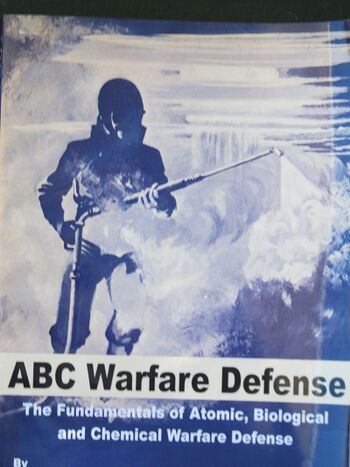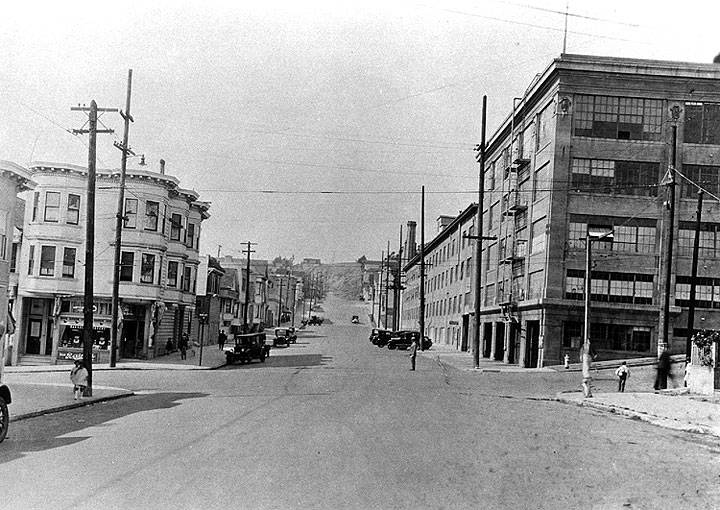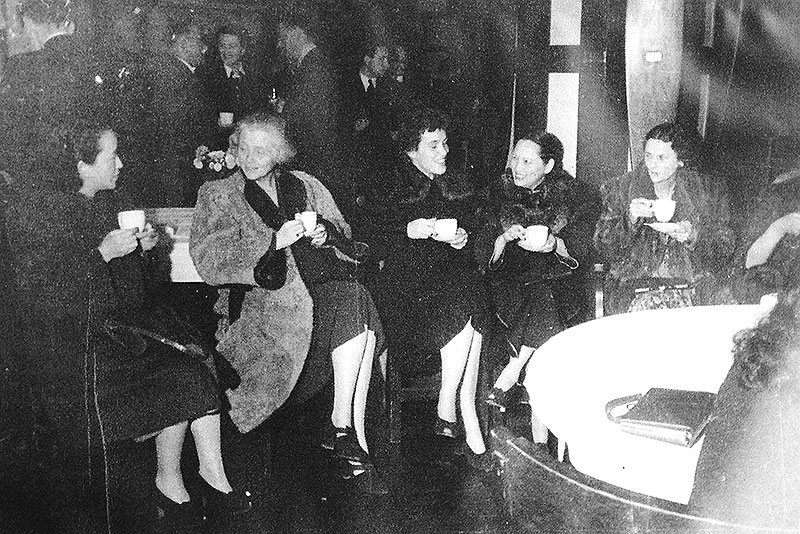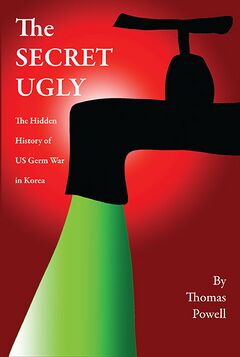Growing Up ‘Red’ in 1950s San Francisco
"I was there..."
by Tom Powell
ABC Warfare Defense, US Bureau of Naval Personnel. This is a textbook; it is a fully illustrated how-to manual on preparing for germ war with illustrations, diagrams, and sample exams. It was reprinted in 2001 from the 1960 edition. It blurs the lines between offensive and defensive weapons.
Photo: Tom Powell
Our first house in San Francisco was on Carolina St. at the very top of Potrero Hill under the shadow of the old water tower. It was a tiny 3-room cottage with what today is a million dollar view. Below the front stairway sprawled the bustling Mission District all the way to Twin Peaks. The left was framed by Bernal Heights with its hilltop pasturelands, and to the right in the distance the two orange towers of the Golden Gate Bridge jutted skyward with the green backdrop of Marin County framed in the haze. John was always reading, but occasionally I could coax him to play cowboys and Indians for a short while with our cap guns in the backyard. Stirring up critters was a favorite pastime of mine, and I was always intrigued by snails with their suction grip, slimy slugs, earwigs with their great mandibles and the occasional giant potato bug.
New Starr King Elementary School was on the shoulder of Potrero Hill. That meant a long downhill walk followed by a steep uphill climb to get to school, and the reverse trek homeward bound. It was a long trudge for a kindergartner and I used sidewalk lines and cracks to invent games to propel me uphill. John and I were good at walking from hikes on camping trips, and our fishing trips to Muni Pier.
On those Saturdays when the [Powell/Schuman] defense committee would meet, John and I would leave carrying our one fishing pole and crab net to board the smelly diesel #53 bus at the top of the hill and ride it to 16th St. and Bryant to transfer to the electric #47 bus which would carry us across town to Aquatic Park. We’d hoof to the bait shop to buy a pound of chum, and then another long walk past the Maritime Museum and out the long curving arc of Muni Pier to our favorite fishing spot. John always carried a book with him and I was left to my own devices. Fishing was a bust from the pier, but crabbing paid off and sometimes we returned home with 3-4 bay crabs large enough for keepers. Sylvia and Bill worked long hours in those days painting, plumbing, and fixing up one old house or other. They rarely drove us anywhere so we learned early to navigate the Muni Bus system.
By the second grade we had moved two streets downhill to Rhode Island Street. This house was built on a shelf of the hill, a flat stretch of road intersected by 22nd St. which was an 18-degree slope strait up. It seemed like a cobblestone wall with stairs cut into it. Our house was on the high side of the flat and was always fondly remembered by us as the “house with 47 steps.” The walk to school got steeper and tripled in length. When it rained, water poured down the sidewalks in sheets and the corner sewer drains were treacherous siphons. My class got a new teacher, Miss Rogers, who was very young and pretty and all the boys and girls thrilled to be in her glow. The class made little flags out of construction paper and dowels, then we formed into a parade and marched around the classroom singing the new song she taught us: “We are marching to Pretoria, Pretoria hoorah! . . . If you’ll be a soldier boy you may come too!”
When I sang the song for Sylvia that evening her eyes widened, her jaw clenched, and she told me she never wanted to hear me sing that song again. Sylvia went straight to the principal the next morning and read her the riot act, because we never sang that song or any other marching songs in Miss Roger’s class again. I have always secretly hoped that pretty Miss Rogers was not an apartheid supporter, but only young and ignorant.
By 1959 we had moved off the upper slopes of Potrero Hill and into a two-story Victorian corner house with a detached carriage house at the base of Potrero Hill. Bill painted both houses barn red after the sedition trial collapsed. All wood houses in San Francisco at that time were painted white. The Dutch Boy paint factory which was the city’s largest paint retailer was kitty-corner from us. The other corners were occupied by Rasmussen’s Grocery and a no-name bar which was always pitch dark inside, the few times I got up the courage to peek through the door. There were tons of kids in this neighborhood, and acres of undeveloped hillside with boulders to climb and cool places to build forts.
In 1930 the Dutch Boy Paint Factory sat on the northeast corner of 24th and Kansas.
Photo: San Francisco History Center, San Francisco Public Library (AAB-5992)
When I entered the third grade I transferred to old Starr King Annex. This was an easier hike to school thanks to a pedestrian bridge over the US 101 Freeway near the Army St. Circle. Starr King Annex was a rectangular two-story wood-and-concrete firetrap. All the classrooms had large windows facing the playground. On each floor behind the classrooms were inside corridors with wide concrete stairs at each end of the building. The memorable feature of the school was the two open metal balconies facing the playground which were connected by a central steel stairway to funnel children down to the playground below. This structure was contemporary with the Golden Gate Bridge and made with gusseted steel girders and hammered rivets. The basement was partially subterranean and contained its corridor, the cafeteria, the girls and boys lavatories, and the mysterious boiler room. It was a typical education factory of its day.
In San Francisco public schools there were two drills we practiced regularly. The fire drill was a continuous alarm. We lined up like soldiers and filed in an orderly way down the metal stairs to our designated position at the far end of the playground. The earthquake drill was a series of short blasts and we would crawl under our desks. In my first year at old Starr King a new drill was added—the A-bomb drill. Once again we lined up like soldiers, but this time we descended inside the building stairwells to the basement. There we sat on the floor cross-legged and bent forward with hands over our heads until the all-clear alarm sounded.
When I told Sylvia about the A-bomb drill, she let out her catch-all Chinese expression— “Ai Ya!” The next time the school was scheduled for an A-bomb drill, a message came for me to report to the principal’s office. I was instructed by the secretary to sit in a chair until the drill was over and school life had returned to normal. Afterwards, I sheepishly crept back into my classroom.
When I angrily confronted Sylvia about it she was very clear that nobody could hide in the basement of that tinderbox building and be safe from an A-bomb blast. The idea of surviving a nuclear war was ridiculous. She hadn’t worked hard to end atmospheric A-bomb testing to allow her children to participate in this fraud of wishful thinking. The vague memory of a three-year old came tumbling back to me of standing on Market St. clutching Sylvia’s skirt as she approached strangers to sign her petition. There were more A-bomb drills at old Starr King leading up to the Cuban Missile Crisis.
By 1964 we had moved across the Mission District to Noe Valley. Bill and Sylvia bought a building with a nine-room flat over a storefront on Church St. The streetcar trundled by with its clanging bell in both directions. Soon they opened Homes of Charm, the antique store they operated with my brother John for the next 35 years. I was an 8th grader at James Lick Jr. High. It was another school factory with home economics on the third floor and various shops in the basement, but it did have lovely tile work in its entry hall. Mrs. Adams, my history teacher, sent the class home with the assignment to write a paragraph defining socialism and another paragraph defining communism. Of course I asked Sylvia for help and she waxed very eloquently about “from each according to their ability, to each according to their need.” I’d also recently begun to pay closer attention to conversations between my parents and their friends about Cuba, and I had overheard that the masses of people in Cuba loved Fidel Castro, and that the boat people arriving in Florida were the wealthy and reactionary elements, and good riddance.
The next morning the students who had completed the assignment read their definitions and Mrs. Adams was pleased to comment about the evils of socialism where the government told you what to think, and red communism where all the stores were government owned and you could not run your own shoe repair shop or grocery store. Finally she called on me and I read the sentences that Sylvia had helped me compose with input from Collier’s Encyclopedia. And because Mrs. Adams had talked about the evil Khrushchev and his missiles in Cuba, I added that the people of Cuba loved Fidel Castro because he had liberated them from the dictator Batista. This was more that Mrs. Adams could handle and she cut me off. “Fidel Castro is the dictator of Cuba.” I turned on her and shouted, “You’re wrong! My mother told me! You don’t know what you’re talking about!” Mrs. Adams flustered bright red and mumbled something. The class was titillated and became unruly. A few students understood the political rebellion I had declared. Most just saw me as entertainment or as a loud-mouth troublemaker. Mrs. Adams recovered class control but fortunately the bell rang and I ducked out of the room not looking back.
Later that afternoon, a hall monitor came to fetch me out of gym class with instructions to report directly to the school counselor’s office. The counselor was a kindly older woman with frumpy clothes. I knew her because she ran a special class where a handful of “gifted students” including me were taught privileged knowledge about prime numbers and the Pythagorean Theorem and such, so I assumed this summons was about that class. It was quite a shock when I arrived at her office door still in my gym shorts to see Mrs. Adams sitting there looking much aggrieved. The room was barely closet sized with the counselor’s desk taking up most of it. I was told to sit down and it seemed like all of our bare knees were almost touching. I felt totally exposed in my gym shorts and it was very uncomfortable.
I was informed that Mrs. Adams was unhappy about my class deportment that morning. Mrs. Adams elaborated that I had been very rude to interrupt and contradict her in class. I had undermined her authority. She was the teacher and she knew the lessons. The counselor asked me to respond. I think they were both fishing for an apology or some contrition on my part, but I was really angry for being cornered like this. I lashed out at Mrs. Adams, “I don’t believe what you say. My mother knows more history than you do and I believe what she tells me.” There was a moment of stunned silence as the two women absorbed this information. So I was excused with the warning that another outburst like the one in class and I would be disciplined.
Sylvia asked how my class went that evening. She was working for the SF Unified School District by that time as a school secretary, and I think she might not have minded stirring up a row over 8th grade history curriculum. But I told her nothing special happened. I didn’t tell her that I had accused Mrs. Adams in front of the class of not knowing what she was talking about. I didn’t tell her that in a moment of anger I had defended her to the school counselor. I didn’t tell her because I didn’t want her stirring up any more drama for me in school. But I think the counselor must have explained to Mrs. Adams who my mother was because she backed off her anti-red rant, stuck to the textbook, and treated me and my opinions with a lot more deference for the remainder of the semester.
The announcement by Bobby Kennedy in 1961 that the US would drop all charges against Bill and Sylvia Powell and Julian Schuman was reason for a great celebration. Bill finished painting the house red and Sylvia proclaimed we would throw a big party. I had no idea what she intended. At ten, a party to me was a dozen people arguing politics and stuffing envelopes, but I knew from the preparations and the growing invitation list that this would be a very different party. The red house was a big building set on the first shelf cut into the corner of a steep hillside. It stood atop a retaining wall rising 10 feet above the sidewalk. It was actually two buildings carved into four units, and all of them would be open for the party. Sylvia sent out printed invitations to everybody who had volunteered on their defense. She decorated with bunting, newspaper clippings and Tibetan prayer flags. Moon and Acati, the Samoan couple who rented the carriage house brought out their drums and torches. Bill bought a large oaken cask of red wine from a warehouse and tapped it with a wood spigot. John and I helped him hoist it up the back stairs strapped to the dolly.
About 150 people turned out for the occasion. They were college professors, lawyers, doctors, union members, journalists, novelists, and artists. It was a cross section of the left-wing intelligentsia of the Bay Area. They had successfully beaten back the red-baiting reactionaries of Congress. The political pendulum in America under the Kennedy Administration was swinging back the other way, and they came ready to celebrate. The upstairs apartment where we lived was completely packed and friends spilled over the entire building —the front stairs, the downstairs the backstairs, the roof garden, the in-law unit, and the carriage house. It was a raucous celebration that lasted long into the night.
The red house party became the first in a long string of parties Sylvia organized after that. Every decade she would throw Bill a big birthday party, and between those milestones she would find two or three other occasions to invite 80-100 people to our home. As the older crowd died off, younger faces appeared. Sylvia and Bill were very good at cultivating younger friends. Sylvia had excellent social skills and office management practice. The year she spent under Madame Sun’s tutelage paid off. Sylvia wrote letters and cards every evening. She remembered everybody’s name, and the names of their children, the particulars of their last conversation and their medical dramas. Sylvia’s parties were an occasion where old activist friends would see each other again to argue politics and social theories. It was a festive glue which bonded this group of leftist Bay Area friends growing old together.
Tea for Lady Cripps; second from left in grey coat, Sylvia Campbell, Mme Sun (Soong Ching-ling.) Mme. Sun frequently used Sylvia to “insulate” herself from visiting dignitaries, foreign diplomats, and others at public functions in an effort to forestall potentially “difficult” questions. As widow of Chinese Republic founder Sun Yat-sen and a dissident member of the “royal family” (sister-in-law of Chiang Kai-shek, sister of Premier T.V. Soong, and sister-in-law of Finance Minister H.H. Hung), any comment she made was certain to get headline treatment.
Photo: Powell Family Archives
This account is excerpted from The Secret Ugly: The Hidden History of US Germ War in Korea by Thomas Powell, Edgewater Editions: 2023.




